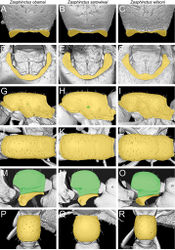Zasphinctus sarowiwai
| Notice: | This page is derived from the original publication listed below, whose author(s) should always be credited. Further contributors may edit and improve the content of this page and, consequently, need to be credited as well (see page history). Any assessment of factual correctness requires a careful review of the original article as well as of subsequent contributions.
If you are uncertain whether your planned contribution is correct or not, we suggest that you use the associated discussion page instead of editing the page directly. This page should be cited as follows (rationale):
Citation formats to copy and paste
BibTeX: @article{Garcia2017ZooKeys, RIS/ Endnote: TY - JOUR Wikipedia/ Citizendium: <ref name="Garcia2017ZooKeys">{{Citation See also the citation download page at the journal. |
Ordo: Hymenoptera
Familia: Formicidae
Genus: Zasphinctus
Name
Zasphinctus sarowiwai Hita Garcia sp. n. – Wikispecies link – ZooBank link – Pensoft Profile
Type material
Holotype, pinned worker, CAMEROON, Centre Province, Mbalmayo, 3.4597, 11.4714, ca. 600 m, rainforest, XI.1993 (N. Stork) (BMNH: CASENT0764654). Paratypes, three pinned workers with same data as holotype (BMNH: CASENT0764646; CASENT0764649; CASENT0764650).
Cybertypes, the cybertype dataset consists of all volumetric raw data in DICOM format, 3D PDFs and 3D rotation videos of scans of head, mesosoma, metasoma, and the full body of the physical holotype (BMNH: CASENT0764654) and/or one paratype (BMNH: CASENT0764650) in addition to montage photos illustrating head in full-face view, profile and dorsal views of the body of both specimens. The data is deposited at Dryad and can be freely accessed as virtual representation of both types (Hita Garcia et al. 2017c[1], http://dx.doi.org/10.5061/dryad.4s3v1). In addition to the cybertype data at Dryad, we also provide a freely accessible 3D surface model of the holotype at Sketchfab (https://sketchfab.com/models/3e5a54cb8ea94028a49f0722bd5eefe8).
Non-type material
DEMOCRATIC REPUBLIC OF CONGO: Epulu, 1.38333, 28.58333, 750 m, rainforest, 1.XI.1995 (S.D. Torti); GHANA: Wiawso, 6.2158, -2.485, ca. 160 m, 25.IV.1969 (D. Leston); IVORY COAST: Tai Forest, 5.75, -7.12, ca. 250 m, rainforest, 18.–20.V.1977 (T. Diomande); UGANDA: Western, Kabarole, Kibale National Park, Kanyawara Biological Station, 0.56437, 30.36059, 1510–1520 m, rainforest, 6.–16.VIII.2012 (different independent collectors: F.A. Esteves, F. Hita Garcia & P.G. Hawkes).
Differential worker diagnosis
See Table 3.
Worker measurements and indices (N=11)
See Table 4.
Etymology
The name of the new species is a patronym in honour of the famous Nigerian writer, environmentalist, and human rights activist Kenule Beeson “Ken” Saro-Wiwa. By naming a species from threatened rainforest habitats after him, we want to acknowledge his environmental legacy and draw attention to the often-problematic conservation situation in most Afrotropical rainforests.
Distribution and biology
The new species has a comparatively wide distribution ranging from Ivory Coast to Uganda, even though it is not known from all countries in-between. However, this is likely based on a sampling artefact considering the rarity of Zasphinctus in general and the poor sampling in most African countries. Therefore, we expect future collections in all countries in-between. All samples are from rainforest habitats at elevations from 250 to 1510 m. Based on the available collection data, the species lives in soil and leaf litter.
Diagnostic comments
Zasphinctus sarowiwai differs in most diagnostic characters from the other two Afrotropical species. Most obviously, it can be separated from the other species by its much larger body size, the prominent median clypeal tooth, and the almost complete lack of surface sculpture. Despite its wide distribution range, there is very little observable variation. Most notably, the colour appears to be generally darker in the specimens from Uganda and Cameroon, which are uniformly very dark brown to black, while the specimens from West Africa tend to have a much lighter abdomen and often relatively bright legs. Furthermore, we observed some variation in the material from Uganda. In some specimens, the subpetiolar process of the petiolar sternum had a slightly weaker, but still distinct, fenestra compared to the material from other localities, and the ventral margin of the process had a posteroventral tooth-like projection. In addition, the anterodorsal margin of abdominal segment III was slightly more angulate in a few specimens while in several other specimens the metapleuron had some weak punctate sculpture. Overall, we consider this variation as geographic and very well within the intraspecific range of such a widespread species.
Original Description
- Garcia, F; Fischer, G; Liu, C; Audisio, T; Economo, E; 2017: Next-generation morphological character discovery and evaluation: an X-ray micro-CT enhanced revision of the ant genus Zasphinctus Wheeler (Hymenoptera, Formicidae, Dorylinae) in the Afrotropics ZooKeys, (693): 33-93. doi
Images
|
Other References
- ↑ Hita Garcia F, Fischer G, Liu C, Audisio T, Economo E (2017c) Data from: Next-generation morphological character discovery and evaluation: an X-ray micro-CT enhanced revision of the ant genus Zasphinctus Wheeler (Hymenoptera, Formicidae, Dorylinae) in the Afrotropics. Dryad Digital Repository. https://doi.org/10.5061/dryad.4s3v1








